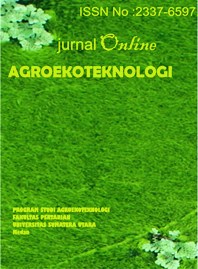Effect of Colchicine on Morphological Diversity of Marigold Plant (Tagetes erecta L.)
DOI:
https://doi.org/10.32734/ja.v9i2.8583Abstract
Marigold is one of the potential commercial flowers and the demand continues to increase. The high demand for marigolds among the public so that plant breeding with colchicine mutations is needed to increase the quality and quantity of marigold plants. The purpose of this study is to determine the effect of colchicine concentration on the morphological diversity of marigold plants. This research was conducted on open land in the Medan Area sub-district, Medan city, Sumatera Utara province and in the tissue culture laboratory of the Faculty of Agriculture Universitas Sumatera Utara, from June to December 2020, using the UPOV (International Union For the Protection of New Varieties Of Plants) marigold descriptor manual. The research was conducted by soaking the seeds with 3 concentrations namely 0 ppm, 50 ppm and 100 ppm. The result showed that marigold plants treated with 100 ppm colchicine produced large flower sizes. Marigold plant morphology changes seen in the treatment of 50 ppm and 100 ppm, namely changes in leaf width, terminal flower stalk length and flower diameter, respectively different from the control plants.
Downloads
Downloads
Published
Issue
Section
License
Copyright (c) 2022 JURNAL AGROEKOTEKNOLOGI

This work is licensed under a Creative Commons Attribution-ShareAlike 4.0 International License.
The Authors submitting a manuscript do so on the understanding that if accepted for publication, copyright of the article shall be assigned to Jurnal Online Agroekoteknologi as well as TALENTA Publisher Universitas Sumatera Utara as the publisher of the journal.
Copyright encompasses exclusive rights to reproduce and deliver the article in all forms and media. The reproduction of any part of this journal, its storage in databases and its transmission by any form or media, will be allowed only with written permission from Jurnal Online Agroekoteknologi.
The Copyright Transfer Form can be downloaded here.
The copyright form should be signed originally and sent to the Editorial Office in the form of original mail or scanned document.











